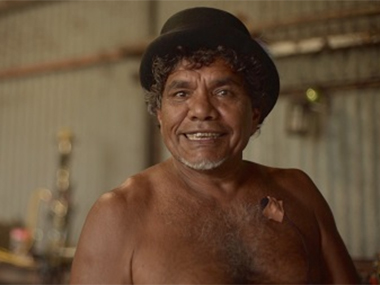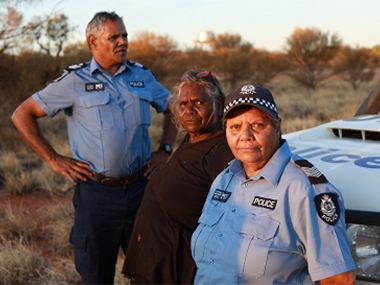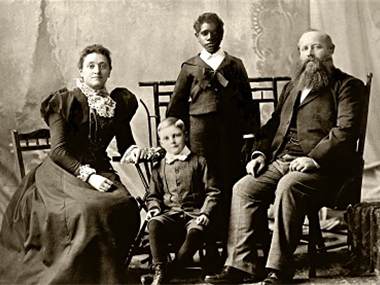ONLINE SYDNEY FILM FESTIVAL

The irrepressible Balang (Tom E) Lewis, who sadly died during the making of 'The Skin of Others' where he saw the character of Douglas Grant as "The role of a lifetime"
Posted by Jeremy Eccles | 09.06.20
Dates:
10.06.20
: 21.06.20
In a foreshortened and online film festival, the normal Sydney winter feast is a comparatively muted affair this year as a result of the COVID crisis. Sadly, only two First Nations films have made the cut, two docos that tackle stories ranging from the very current issue of police relations with Indigenous communities to a dramatised tragedy of a potentially great man – another David Unaipon - from the FNQ tropical forests, taken as a child and brought up Scottish in Sydney!
Let's start there with 'The Skin of Others', made over many years by Tom Murray – the director of an earlier excellent Indigenous doco, 'Dhakiyarr v The King', and featuring the late, great Tom E Lewis – referred to for cultural reasons throughout as Balang Lewis. And he's at the centre of this film as much as Douglas Grant, its supposed subject.
I originally called this film a history, as it's set in the late 19th and early to mid 20th Centuries and involves the life of a real person. But, the way Murray has chosen to edit the film using all sorts of meta-theatrical tricks – casual rehearsals with Balang, episodes from a 1950s ABC radio doco, interpretations from six other commentators, and multiple versions of the story behind Grant's removal from FNQ – it becomes a little confusing as history and not quite as emotionally engaging as I would have liked. Such engagement as I felt was more with Lewis than poor old Grant, who becomes a metaphor for the “two-sided story” that is as much Lewis's as Grant's. For as Balang points out, he must be part-Welsh, given his surname. “But I don't feel it”, he insists, before dying ahead of the film's completion, knocking Murray for six.
Behind some of the confusion are Robert Grant and his wife; he a collector for the Australian Museum in Sydney and a skilled taxidermist – so skilled that the soon-to-be-assassinated Duke Franz Ferdinand came to study the animals in Sydney that he'd brought back from the tropics prior to heading out to massacre as many of them as possible. Is it possible that such a representative of that august Museum would send in gunmen to shoot up a Blacks Camp in order to drive the men away in order to purloin their artefacts? It's one theory – with the 5 or 6 year old Douglas purloined at the same time? Or, was there a tribal war that left the child orphaned, to be rescued by the generous Mrs Grant and smuggled out of Queensland?
There are even more possibilities, though the suggestion that a eugenic motive existed to totally detribalise this child of remote Australia, offering absolute equality with his white step-brother and giving him a Scottish accent with matching bagpipes is only hinted at. Certainly the ruse that he was a Black Scotsman allowed him to sign up for the 1st World War when Aborigines were denied that 'right', becoming a respected Sergeant before being wounded and captured by the Germans at Bullecourt. He would even be accepted into the Lithgow RSL after the War, but being a 'Clever Abo' with a theory that Mankind developed in Australia based on a spurious footstep in ancient sandstone wasn't enough to save him from constant racism, leading to drink and delusions that took him to Callan Park.
“The End of a Human Experiment” was the newspaper headline that accompanied his incarceration, though Balang Lewis denies the accompanying suggestion that Grant had become “White of heart and Black of skin”. For the 1928 Coniston Massacre had aroused him to make a “Call for Justice by Douglas Grant”. Film-maker Murray also scripts the interesting comment that the creation of the ANZAC myth at Gallipoli may have been in part an effort to “erase the earlier history” of the massacres that accompanied a century of frontier expansion. I wonder what the War Memorial in Canberra would think of that?
And I wonder what the cop who was having “a bad day” when he kicked an Aboriginal kid to the pavement recently would think of police Sergeant Wendy Kelly's assessment that “Vanessa had had a hard day” when she started throwing stones at the community school, and simply needed a quiet talking to?
But then we're now in Warakurna – “800kms from anywhere” - in WA and both the Ngaanyatjarra community and the cops are Aboriginal. “Before Revis (Senior Sgt Revis Ryder), the cops just came to arrest people”, recalls one relaxed local. And that's despite the fact that both the First Nations Sergeants have barely made a start on the Ngaanyatjarra language - “only little words,” as Ryder admits in explaining his difficulties in training the local footy team. They do, however spend much time having a go at their word books. And, as Kelly departs at the end – having shared her heroic backstory of recovery from a traumatic start to life - to tackle a major State Reconciliation project, she insists that “learning the language” is the best way to allow “every community to trust their police”.
But, right now, this is the only 100% Indigenous-run police station in Australia. And the film makes its case for the difference through a joyous bush trip organised by a ngangkari elder with Kelly to obtain “natural Dencorub” for her colleague's bad back, and the community's need to organise a ceremony to respond to the deaths of two passing motorcyclists on bush roads – totally unknown to the locals.
Indigenous director Cornel Ozies offscreen makes the case for compulsory training for all police cadets in Aboriginal culture and the history of both the Stolen Generations and the massacres that police were involved in, so that they might have “an understanding that there's a reason why there's a bit of aggression towards (them)”. One might argue that there's also a case for more self-reliance in Indigenous communities – power to the elders. After all, the film is called 'Our Law'.
But Ozies doesn't actually take us to the political extremities in his film – and, sadly, he doesn't represent Warakurna's busy artistic community and their role in the social and financial fabric of the community. But it's a warm-hearted film which will be seen later on NITV.
Access to the ten new Australian documentaries selected for competition in the SFF this year starts just after midnight tonight and remains available for 10 days! You can also get introductions from their makers and Q&A sessions afterwards. A ticket to each feature costs $14, or the whole lot can be bundled at $99. The same cost structure applies to the ten features and documentaries directed by European women filmmakers which makes up the rest of the festival. Earlier, there was a free world-wide film festival in which the Aussie contribution was the two Indigenous films – Ivan Sen's original 'Mystery Road' and Rachel Perkins' 'Mabo'; selected because “they were very big moments for Sydney Film Festival”.
Share this:
»  del.icio.us
»
del.icio.us
»  Digg it
»
Digg it
»  reddit
»
reddit
»  Google
»
Google
»  StumbleUpon
»
StumbleUpon
»  Technorati
»
Technorati
»  Facebook
Facebook
Contact Details

(L to R) Brevet Sen. Sgt Revis Ryder, Yarnangu elder and ngangkarni Daisy Ward, Brevet Sgt Wendy Kelly.

A photo from the 1890s of young Douglas Grant with his Sydney family headed by museum man Robert Grant.
Further Research
News Tags: Aboriginal-Police relations | Cornel Ozies | Douglas Grant | Jeremy Eccles | Sydney Film Festival | Tom E Lewis | Tom Murray | Warakurna
Exhibition Archive
- 26.06.20 | Fashion Goes Indigenous
- 02.06.20 | RIP Malu Gurruwiwi – Custodian of the Banumbirr
- 11.05.20 | BIDYADANGA CLOSE-UP
- 07.05.20 | Boomerang Back to the Start
- 29.04.20 | Cooked???
- 24.04.20 | Mrs Ngallametta
- 23.04.20 | NATSIAA Pre-Selections Revealed
- 20.04.20 | CIAF 2020
- 10.04.20 | Marginally Good News
- 06.04.20 | ON & OFF IN ABORIGINAL ART
- 26.03.20 | Out on Country!
- 19.03.20 | BIENNALE OF SYDNEY 2020
- 13.03.20 | LAURIE NILSEN
- 03.03.20 | EMILY v CLIFFORD
- 02.03.20 | The Ephemeral and the Ineradicable
Advertising

